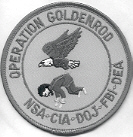
Collecting insignia from the Federal Bureau of Investigation since 1999.
This site is not officially sanctioned by the Department of Justice, The Federal Bureau of Investigation, The Louisville Metro Police Department, or any of their entities.
© Copyright 1999-2006. All Rights Reserved.
On June 11, 1985, Fawaz Yunis and four other men boarded Royal Jordanian Airlines Flight 402 shortly before its scheduled departure from Beirut, Lebanon. They wore civilian clothes and carried military assault rifles, ammunition bandoleers, and hand grenades. Yunis took control of the cockpit and forced the pilot to take off immediately. The remaining hijackers tied up Jordanian air marshals assigned to the flight and held the civilian passengers, including two American citizens, captive in their seats. The hijackers explained to the crew and passengers that they wanted the plane to fly to Tunis, where a conference of the Arab League was under way. The hijackers further explained that they wanted a meeting with delegates to the conference and that their ultimate goal was removal of all Palestinians from Lebanon.
After a refueling stop in Cyprus, the airplane headed for Tunis but turned away when authorities blocked the airport runway. Following a refueling stop at Palermo, Sicily, another attempt to land in Tunis, and a second stop in Cyprus, the plane returned to Beirut, where more hijackers came aboard. These reinforcements included an official of Lebanon’s Amal Militia, the group at whose direction Yunis claims he acted. The plane then took off for Syria, but was turned away and went back to Beirut. There, the hijackers released the passengers, held a press conference reiterating their demand that Palestinians leave Lebanon, blew up the plane, and fled from the airport.
An American investigation identified Yunis as the probable leader of the hijackers and prompted U.S. civilian and military agencies, led by the Federal Bureau of Investigation, to plan Yunis’ arrest. After obtaining an arrest warrant, the FBI put "Operation Goldenrod" into effect in September 1987. Undercover FBI agents lured Yunis onto a yacht in the eastern Mediterranean Sea with promises of a drug deal, and arrested him once the vessel entered international waters. The agents transferred Yunis to a United States Navy munitions ship and interrogated him for several days as the vessel steamed toward a second rendezvous, this time with a Navy aircraft carrier. Yunis was flown to Andrews Air Force Base from the aircraft carrier, and was taken from there to Washington, D.C. In Washington, Yunis was arraigned on an original indictment charging him with conspiracy, hostage taking, and aircraft damage. A grand jury subsequently returned a superseding indictment adding additional aircraft damage counts and a charge of air piracy. Yunis was eventually convicted at trial and sentenced to 55 years in a federal prison.
Source: United States v. Yunis Court Briefing
